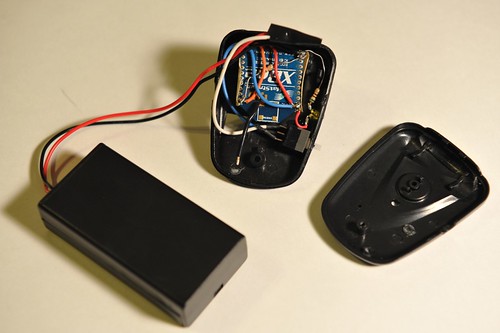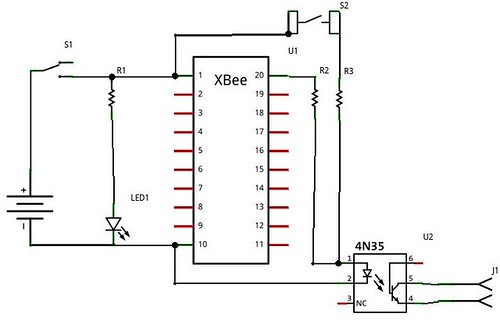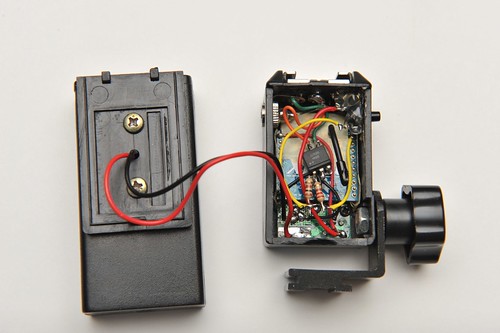A year and a half ago, I started dabbling with using off-camera flash units, in order to exact better control over the lighting in my photographs. Of course, to do this, I had to invest in some equipment. I was able to pick up some used flashes for pretty cheap on Craigslist, however there were only two choices for wireless remote controls for them: Quality but expensive (Pocket Wizards), or cheap and questionable (Cactus triggers). Of course, I went for the cheap ones!
Well, I got what I payed for, and they stopped working after a few weeks. Rather than toss them, I had the bright idea of replacing their guts with some xBee transmitters. This actually worked pretty well, but I didn’t get around to documenting them until now (though I did upload some photos). The idea is really simple- just configure the xBees in direct pin mode (see Rob Faludi’s example, my notes are long gone), and hook them up to the flash sync ports on the camera and flash. Using these transceivers, I am able to reliably pull 1/120th of a second sync speed (probably fine for studio, but not daylight), with an excellent range (something like 1/8th mile outdoors). Though they work fine, the construction quality is definitely questionable, so I’m kicking around designing new enclosures and having them printed.
A quick explanation of the schematics is available after the break, and the full photoset is here.
The Transmitter:

R1 and R2 are 220 ohm
S1 is the on/off switch, and S2 is a momentary ‘test output’ switch
J1 is the flash sync from the camera- the top pin is the tip of the connector, and the outside is the ring.
Crammed inside the shell from the Cactus transmitter, it looks like this:

The Receiver (build as many of these as you want):

R1 and R2 are 220 ohm, R3 is 100 ohm
S1 is the on/off switch, and S2 is a momentary ‘test output’ switch
J1 is the flash sync from the camera- the top pin is the tip of the connector, and the outside is the ring.



Pingback: C i b o M a h t o . c o m » A short link to nearly nowhere
Great project! I picked up some XBee’s to try this very same thing(just haven’t managed to get to it yet.) I believe the two commands ATIR (sample rate) and ATIT (samples before transmit) might allow 1/250 if you set them to 4 & 1.
Thanks! Let me know if you get yours working. I’m thinking about rebuilding mine, and designing some custom cases for it. The current ones work ok but are kind of clunky, and I fear not very robust.
Hi – I was wondering if there is any update to this – I’d like to try it myself, but I’m hoping to get to 1/250 sync (trying to run a qflash outdoors). Were you able to make it work? I have pocketwizards, but rolling my own setup would be awesome.
Hi Jim! No, I unfortunately haven’t taken the time to get back to this, although I really should now that I have gotten back into making PCBs :-). I’ll let you know if and when I get to it. The biggest issue has been that it is too much of a pain to connect up the xBees to a serial port, because they aren’t mounted in anything.